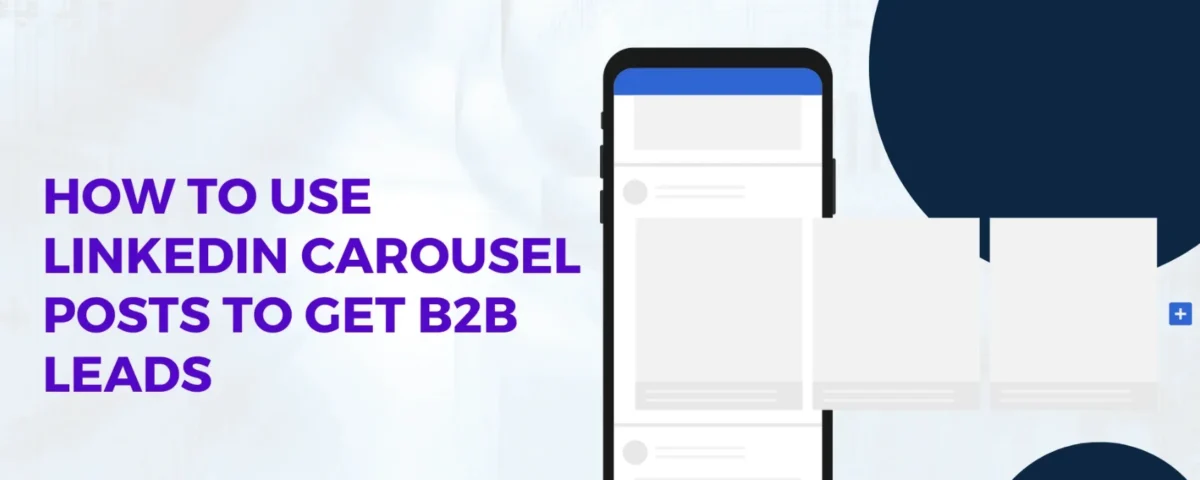
The Best Posting Time on Instagram for Maximum Engagement in 2025

How DevOps & Cloud Fit Together in 2025

How to Use LinkedIn Carousel Posts to Get B2B Leads
LinkedIn is no longer just a platform for resumes and networking. It has become the go-to channel for B2B marketing, thought leadership, and lead generation. Among the content formats available, LinkedIn carousel posts stand out because they combine visuals, storytelling, and interactivity. When used strategically, they can help you capture attention, nurture trust, and generate qualified B2B leads.
This guide will show you how to use LinkedIn carousel posts step by step so you can attract your target audience and turn engagement into business opportunities.
Step-by-Step Guide to Using LinkedIn Carousel Posts for Lead Generation
Before diving into the tactical steps, it is important to understand that carousel posts are not just design exercises. They are part of a structured content strategy that aligns with business goals, audience pain points, and lead generation objectives. This transition will help you approach the next steps with clarity and purpose.
Step 1: Understand Why Carousel Posts Work for B2B
Carousel posts are swipeable slides that let you break down complex ideas into digestible chunks. For B2B audiences, this format is highly effective. It captures attention, encourages interaction, and boosts LinkedIn’s algorithm performance.
- Hold Attention Longer: Carousels increase dwell time which signals relevance to LinkedIn’s algorithm.
- Simplify Complex Ideas: They allow you to present frameworks, case studies, or data in a visual and easy-to-follow way.
- Encourage Interaction: Readers need to swipe through to get the full story, which boosts engagement.
Step 2: Choose Topics That Attract Your Target Audience
The relevance of your topic determines whether your carousel succeeds or fails. Choosing the right theme means speaking directly to your buyers’ pain points and aspirations.
- Create Guides: Share step-by-step frameworks or industry best practices that provide actionable advice.
- Use Case Studies: Showcase results by breaking down successful client stories into digestible visuals.
- Repurpose Content: Turn existing webinars, eBooks, or reports into short, engaging carousel slides.
Step 3: Design Carousels That Stop the Scroll
A strong design is what makes people pause and engage instead of scrolling past. Visual appeal is just as important as the content itself.
- Use Bold Headlines: The first slide should have a headline that promises clear value.
- Keep Text Minimal: Avoid overcrowding. Let visuals and concise statements deliver the message.
- Apply Consistent Branding: Stick to your colors, fonts, and logo placement to build recognition.
- Use Simple Visuals: Add icons, charts, or graphics that make information easier to grasp.
Step 4: Optimize Each Slide for Storytelling and Value
Carousels are most powerful when they take the reader on a structured journey. Each slide should build on the previous one until a clear takeaway is delivered.
- Start with a Hook: Use a bold statistic, question, or problem statement on the first slide.
- Build the Story: Guide readers step by step with each new slide, offering value.
- Finish Strong: Conclude with a final insight that reinforces the key message and primes action.
Step 5: Add Compelling CTAs That Drive Leads
Without a call-to-action, a carousel post stops at engagement. The goal is to direct viewers toward meaningful next steps.
- Use Direct CTAs: Add actions like “Download the full guide,” “Book a demo,” or “Message us to learn more.”
- Encourage Comments: Ask readers to share their opinions or experiences to spark conversation.
- Link to Resources: Drive traffic to landing pages or gated content to capture quality leads.
Step 6: Post Strategically for Maximum Visibility
Posting strategically ensures that your content reaches the right audience at the right time. Distribution has a direct impact on visibility.
- Publish in Business Hours: Focus on peak times when B2B professionals are active.
- Target Midweek Days: Tuesdays through Thursdays generally perform better for engagement.
- Use Niche Hashtags: Add three to five industry-specific hashtags for relevance.
- Tag People and Brands: Mention collaborators, partners, or clients to extend reach.
Step 7: Track Performance and Refine Approach
The best strategies evolve. Monitoring results and refining your process ensures consistent growth in lead generation.
- Track Key Metrics: Measure impressions, clicks, saves, and lead submissions.
- Identify Winning Topics: See which themes perform best and create more around them.
- Test Variables: Experiment with different CTAs, designs, and posting times for optimization.
Conclusion
LinkedIn carousel posts are one of the most powerful tools for B2B lead generation. They combine visual storytelling with interactivity, making it easier to educate, engage, and convert your audience. By choosing the right topics, designing carousels that stand out, and including strong CTAs, you can turn passive scrollers into active business leads.
If you want to maximize your LinkedIn strategy, focus on consistency and optimization. Each carousel should not only deliver value but also move your prospects closer to becoming customers. With the right execution, LinkedIn carousels can become a steady pipeline for high-quality B2B leads.

